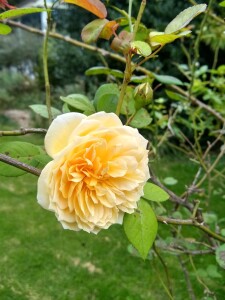 Spring comes every year and, in general, the average garden looks its best in the months of April, May and June. Green returns to the landscape, plants leap out of the earth, and the weeds haven’t had a chance to grow to the epic sizes they sometimes reach in the summer.
Spring comes every year and, in general, the average garden looks its best in the months of April, May and June. Green returns to the landscape, plants leap out of the earth, and the weeds haven’t had a chance to grow to the epic sizes they sometimes reach in the summer.
Gardeners are also fresh from winter downtime and anxious to make things grow. The failures of the past are in the rearview mirror and optimism generally reigns. This optimism is enhanced by garden center pallets full of fresh young plants, many of which are already in bloom. There are no bedraggled sale-rack specimens to remind patrons of the ephemeral nature of all things.
My garden and the gardens of my neighbors look especially good this year and everyone I know has remarked on the size of their roses, the beauty of their enormous peony blooms and the fact that the lilies are on track to become taller than they have been in years. Even the newly opened sundrops or Oenothera suffruticosa in my front garden seem sunnier this year, flying in the face of the poor air quality that has plagued the area recently.
What caused all of this? Two words—warmth and water. My area had an “open” winter, with record low levels of snow and relatively small amounts of cold wind, which is almost worse than snow at killing off plants. The spring was long, cool, and relatively wet, sending lots of moisture to plant roots. Like marathon athletes, many plants love that kind of slow, steady hydration and respond with peak performance.
The result was less “winter kill” than normal, as well as an increase in tall stalks and big blooms. Now those of us who are taking victory laps around the late spring garden have several challenges—keeping the phenomenal growing year going, coping with the weeds that have benefitted from the same advantageous climate conditions, and lack of time to cope with all the spring garden chores.
To keep the good thing going, walk back to the conditions that created the phenomenon. We can’t do anything about the weather, but we can make sure that we water and fertilize–especially annual plants and the spring showhorses like roses. Repeat bloom calls for nourishment. I use an organic fertilizer that is a byproduct of fish processing. It seems to work well, but most gardeners have favorite products. The important thing is to use them according to manufacturers’ directions.
Water is essential, but use it wisely. Plants are all stressed in hot weather, but some are genetically programmed to withstand or even thrive under hot dry conditions. Lavender, yarrow, and a number of Mediterranean plants dislike “wet feet”. Save the water for thirsty specimens like hydrangeas, roses, daylilies, containerized plants, and annuals. Plants in the latter two categories may need daily watering in hot weather.
You may not talk to your plants, but watch them daily. Plants, like small children, generally communicate their needs if you are paying attention and understand the signals. Leaves are the best indicators of need. It is easy to spot droopy leaves on traditional annuals and perennials, but not as easy to assess need with succulents. If the succulent’s leaves are plump and firm, the plant is fine. If leaves seem flaccid, the plant is crying out for water.
The challenges of weeds and time are intertwined. Weeds thrive when gardeners have busy schedules that take them away from garden chores. Mulch helps to keep weeds under control, so time spent spreading mulch is a good investment.
Beyond that, use small time increments to pull weeds in specific areas. It is amazing what you can accomplish in ten minutes. Pull the biggest and most aggressive weeds first. Thugs like pokeweed and poison ivy thrive on inattention and grow fast. I also find that weeding can be much more successful if I start by using my large garden fork to loosen soil in areas with an abundance of weeds, before pulling individual plants. This saves time and energy and does not hurt more desirable plants.
The bottom line is, do your best to keep this year’s good thing going, but don’t let yourself get overwhelmed. As gardeners, our reach often exceeds our grasp. We have to admit that and rest easy.
Remember that satisfaction comes from process, not just results.
